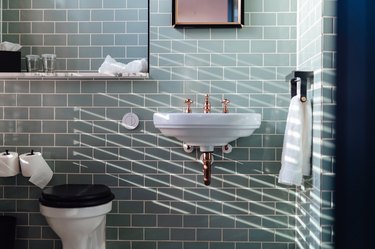
You're enjoying a nice warm shower with the perfect water pressure when you hear the dreaded flush. You know what comes next: That perfect shower of water slows down to what feels like a trickle. Loss of water pressure when you flush your toilet can be a sign of problems in your plumbing system. Figuring out which issue is to blame for your low water pressure can solve the problem.
Tip
Low water pressure when flushing the toilet can be due to the type of shower valve you have or issues with the plumbing, including restricted or leaking pipes.
Video of the Day
Pressure-Balance vs. Thermostatic-Mixing Valves
When your toilet flushes, it refills using cold water, which can limit how much cold water goes to your shower and other fixtures. If you have a traditional pressure-balance shower valve, which has one handle to adjust the temperature and pressure, that loss of cold water can become more noticeable. This type of valve works by adjusting the hot and cold water pressure ratio to keep the water at a consistent temperature. So when the cold water pressure decreases, the valve reacts by also lowering the hot water pressure to keep the ratio balanced.
Video of the Day
Switching to a thermostatic mixing valve can minimize the water pressure drop you experience when someone flushes the toilet. This type uses separate handles for water pressure and temperature. Instead of responding to the pressure, it responds to the temperature changes, allowing it to maintain the temperature without changing the water pressure.
Incorrect Pipe Sizing or Restrictions
Restricted plumbing pipes can cause water pressure issues in your home. If you have an older home or someone other than a licensed plumber previously did work in the home, the plumbing pipes leading to the bathroom might be undersized. In other situations, the pipes can be restricted due to buildup inside the pipes. These situations restrict how much water flows into the bathroom. When you flush your toilet, it can take a large amount of that water, leaving the shower and other fixtures with less.
If you suspect a problem with your pipes, it's best to hire a plumber. A professional can evaluate the situation and inspect the pipes to ensure they're the properly size. Replacing bad pipes is a job for a professional to ensure they use the correct pipes and install them well to avoid leaks.
Leaking Plumbing Pipes
Another issue that can decrease overall water pressure in your home is a small leak in the plumbing. When the toilet flushes and draws cold water, it leaves even less for other fixtures. Plumbers can help find the leaks and repair them quickly before they cause more serious damage.
Water Pressure Regulator Issues
Your home should have a water pressure regulator on it to reduce the water pressure as it enters your home. You can adjust the water pressure regulator to increase the water pressure if it's low overall. You'll need an adjustable wrench to loosen the lock nut and adjust the screw. This can improve the overall water pressure and minimize pressure loss when you flush the toilet.
However, you don't want to make the pressure too high. A good range for most homes is between 40 and 60 psi. Anything above 80 psi can damage your home's plumbing, including breaking pipes and damaging connections. If your pressure is good overall, adjusting the regulator to increase the pressure could cause issues.
Checking Your Toilet
Checking your toilet to ensure it's working properly can also help your overall plumbing situation. Look for any leaking from the tank or around the base that could affect water usage. Ensure the flapper sits securely in place and the chain only has about 1/2 inch of slack to allow it to open and close properly. Check the water level in the tank to ensure it's about 1 inch below the top of the overflow tube. Adjust the water level by squeezing the clip on the cylinder float.